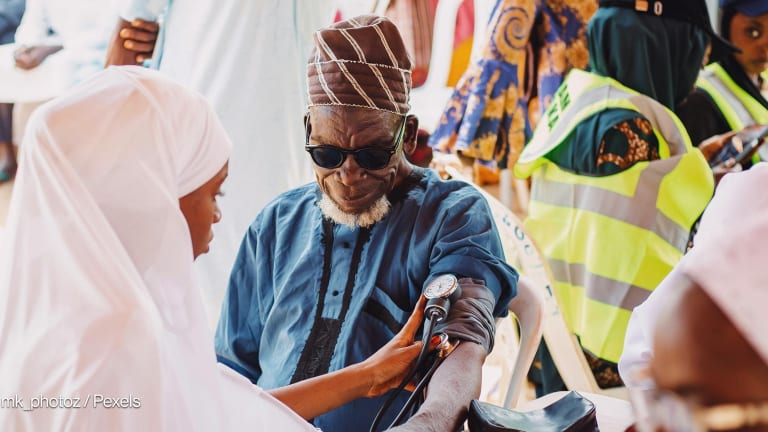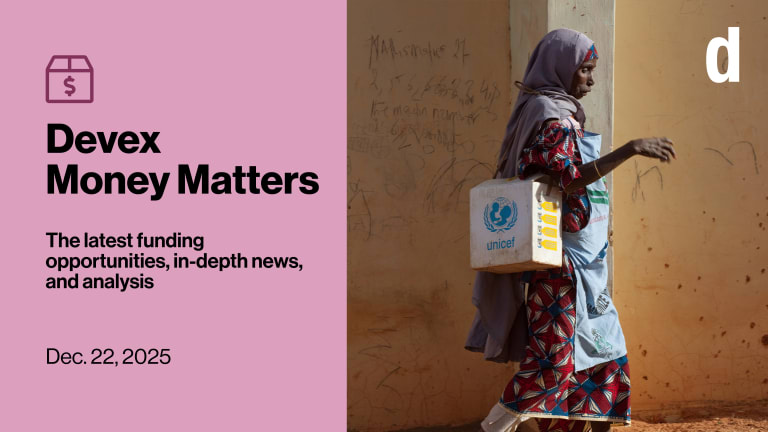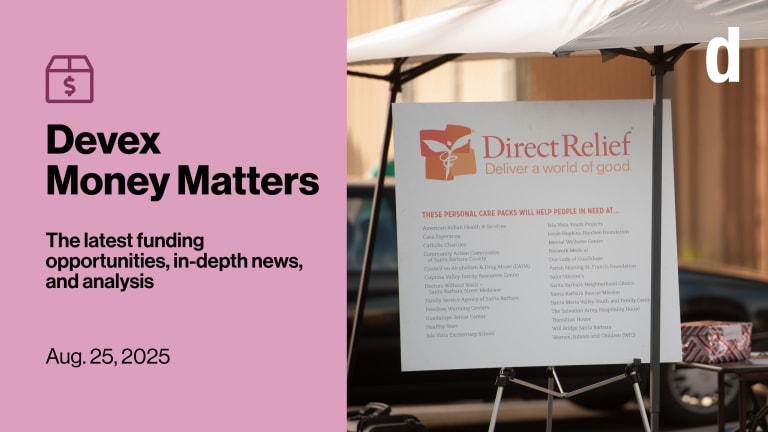DevExplains: What are the largest organizations in aid?
Which is the largest organization in the world of development? It depends who you ask. And what you're counting.
The world of aid is full of big numbers. Hundreds of billions of dollars are spent each year, on work by millions of people, to help billions more. Over the last years, Devex has written scores of articles analyzing the data from many of the organizations working in this field, and in doing so, we’ve identified a number of organizations that claimed — or were claimed by others — to be the largest in the sector. So which is the biggest? It turns out it all depends on which criteria you use. Here’s a list of half a dozen different metrics for the largest organization in development, along with the contenders in each category. Who’s the richest? This crown probably goes to the Bill & Melinda Gates Foundation, with its endowment of $53.3 billion. The Gates Foundation is a behemoth of international aid. It spends billions a year on international causes, and it’s among the largest donors to both Gavi, the Vaccine Alliance, and the World Health Organization. While the Gates Foundation isn’t the biggest spender in international aid, its annual budget is comparable to all but the big five spenders on international development. If it were a country, it would be hovering around ninth place in the list of largest providers of official development assistance in 2021 — somewhere equivalent to Sweden and the Netherlands. But perhaps surprisingly, there is another contender, according to this metric. And that’s the Novo Nordisk Foundation, which through a holding company, owns a controlling share in the pharmaceutical company of the same name, and which funds international medical treatment and research. Unlike the Gates Foundation, its primary focus isn’t on international development, but it does fund significant humanitarian work. The foundation is worth 396 billion Danish kroner — over $52 billion — as of 2021. Today, that’s actually less in dollar terms than the Gates Foundation, due to a recent sharp rise in the dollar’s value. Historically, it has usually been worth a lot more. But unlike the Gates Foundation, which intends to spend down its endowment and exist only for another 25 years, the Novo Nordisk Foundation plans to exist in perpetuity, so its spending hovers around $1 billion a year. Another contender which might bypass the Gates Foundation in the near future is Wellcome, the British-based health foundation, which appears to be pivoting more toward an international development focus. At the turn of the year its total wealth was $38.2 billion, and for more than a decade, that wealth has been growing fast — 33% in the last year alone. Right now a collapse in the value of the pound means Wellcome would be well behind on any dollar-denominated list, but it could be richer than both the Gates Foundation and the Novo Nordisk Foundation by the end of the decade. Who employs the most people? The clear winner of the largest organization by staff numbers appears to be BRAC. The Bangladeshi-based NGO is routinely described as the world’s largest, and it says it employs around 100,000 people. We should caution that these numbers aren’t easy to cross-check. There is no universal register of aid organizations by staff numbers. However, a look at other organizations which might challenge for this spot shows they are nowhere close to BRAC. World Vision, for example, may be the world’s biggest NGO by income, and it says it has 34,000 staffers. Médecins Sans Frontières is listed as having 45,000 staffers. The United Nations employs 35,700 people directly, and all U.N. agencies combined employ 119,870. So if we were to treat the U.N. as a single employer, it would be the largest, but that is not necessarily a fair comparison because U.N. agencies have a high degree of independence and not all of the U.N. is focused on development. And it’s worth putting this into context. None of these entities is even in the same order of magnitude as the world’s largest employer — the U.S. armed forces, which has 3 million people on the payroll. Rounding out the top 10 include the armed forces of China, India, Russia, and North Korea, railway companies in India and China, private sector megacorps Walmart and McDonald’s, and the British National Health Service, all of which employ at least 1.7 million people. Who spends the most? Five countries dominate development spending — the United States, Germany, France, Japan, and the United Kingdom. Between them, they account for roughly 70% of all ODA. Most of these countries, in turn, have a single development agency that dominates their spending. So it’s not surprising that there’s a clear winner for the biggest bilateral spender — the U.S. Agency for International Development, the biggest development agency in the world’s richest country. USAID has a budget of $29.4 billion for 2023 — more than the total aid budget of any other nation except Germany, and roughly a sixth of all ODA. The question starts to get a bit more complex, however, when we factor in multilateral agencies. In 2021, around $10 billion of USAID money was channeled straight to large multilaterals such as The Global Fund to Fight AIDS, Tuberculosis and Malaria and the World Food Programme. So you could argue that a fairer comparison is between USAID’s remaining budget and the largest multilateral agencies. Even if we exclude multilateral cash, USAID spent comfortably more than WFP and UNICEF, the biggest U.N. agencies. But perhaps the hardest comparison to make is with the World Bank, which in 2021 provided a mixture of funding worth anywhere between $84.3 billion and $109.7 billion, depending on what you count. But this was mostly loan finance. If it was calculated as grant-equivalent money, in the same way ODA is, it’s not clear what it would be worth. Who reaches the most people? Given that helping people is the goal of development, it seems reasonable to include “most people helped” in this list of metrics for the largest organization in development, even though it’s not a question with a definitive answer — it depends on how you define “reached” or “helped,” for a start. One strong contender is WFP, which defines itself as the world’s largest humanitarian organization. It’s not clear exactly what metrics it uses to reach that definition, and when Devex reached out to try and clarify, WFP did not respond. But the organization fed 128 million people last year, so it could certainly make a case to have provided more people with humanitarian support than anyone else. Another organization with a significant reach is UNICEF, which says it supported over 300 million children. Other organizations with immense reach include the Global Fund, which distributed 133 million mosquito nets to people; Gavi, which immunized 64 million children in 2020; and WHO, which aims to influence health care for 3 billion people, and says it has reached more than 600 million so far — although this goal is a collaborative one, so WHO’s individual impact is a little harder to track. Who works in the largest number of countries? Unlike other definitions on this list, this question appears likely to end in a score draw, given that there are several organizations working in just about every country in the world. On self-reported numbers, the answer may be WHO, which says that it works in 194 countries. However, this is slightly questionable because there’s some debate over exactly how many countries there are in the world. There are only 193 members of the U.N., for a start, but then there are many questions over who else might have a claim to be a country. Different sources take different approaches to areas such as Tibet, Taiwan, Palestine, and Vatican City, all of which claim statehood. This makes it hard to work out if there’s a difference when the International Committee of the Red Cross says that it works in 191 countries, while UNICEF says it works in 190. Does WHO work in more countries, or does it just recognize more nation states? In practice, these, and a handful of other organizations, are effectively worldwide.
The world of aid is full of big numbers. Hundreds of billions of dollars are spent each year, on work by millions of people, to help billions more.
Over the last years, Devex has written scores of articles analyzing the data from many of the organizations working in this field, and in doing so, we’ve identified a number of organizations that claimed — or were claimed by others — to be the largest in the sector.
So which is the biggest? It turns out it all depends on which criteria you use.
This story is forDevex Promembers
Unlock this story now with a 15-day free trial of Devex Pro.
With a Devex Pro subscription you'll get access to deeper analysis and exclusive insights from our reporters and analysts.
Start my free trialRequest a group subscription Printing articles to share with others is a breach of our terms and conditions and copyright policy. Please use the sharing options on the left side of the article. Devex Pro members may share up to 10 articles per month using the Pro share tool ( ).
David Ainsworth is business editor at Devex, where he writes about finance and funding issues for development institutions. He was previously a senior writer and editor for magazines specializing in nonprofits in the U.K. and worked as a policy and communications specialist in the nonprofit sector for a number of years. His team specializes in understanding reports and data and what it teaches us about how development functions.








